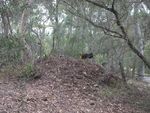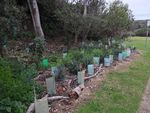Winter 2018 Issue 76 - Pittwater Natural Heritage ...
←
→
Page content transcription
If your browser does not render page correctly, please read the page content below
Winter 2018 Issue 76
Pittwater Natural Heritage Association – thinking locally, acting locally
PNHA Update
Ingleside Land Release
In their latest update on the Ingleside Planned
Precinct, the Department of Planning and
Environment flag their intention to release the
rezoning package for the Ingleside Precinct in
late 2018. It appears that they are being delayed
by the need to do more work on bushfire risk
assessment and biodiversity certification.
PNHA is still pushing for improved fauna
corridors and better protection for biodiversity. For example we
A vegetation community typical of
believe there are serious flaws in the assessment and treatment
Coastal Upland Swamps. This area
of Coastal Upland Swamps within the precinct, an ecological
has not been identified as a CUP by
community listed as endangered by both state and federal
the DP&E biodiversity consultant.
governments.
Our submissions and lobbying have already led to additional investigations of this endangered
ecological community, but we believe that there are still more to be found, the full extent of some
has not been mapped, and the proposed protections for this EEC are not adequate.
PNHA is planning to engage our own
biodiversity consultant to investigate fully
the number and extent of Coastal Upland
Swamps in the Ingleside Precinct.
Development too close to such swamps
would affect the hydrology that creates
them, causing their destruction.
Seepage from swamps still occurring
weeks after a rain event. Note the
holes of freshwater crayfish in the
bank in Waratah St Ingleside
1
PagePNHA Grant Projects
Mona Vale Basin Bushcare support
This $12000 grant to PNHA from the NSW
Government Stronger Communities program
provides the volunteers with more help from
contract bush regenerators. The site, at the
eastern end of Bassett St, contains coastal dune
vegetation on one side and Littoral Rainforest
Endangered Ecological Community on the
opposite side. A lot of planting has been done on
the formerly very weedy site and despite the hot
dry summer is making good progress.
The bushcare group meets on the first Saturday morning of each month. Contact Karin Nippard,
Northern Beaches Council Bush Management Officer on 0417 040 945 if you’d like to help.
Careel Creek Vine Weeds project
A Community Planting
Day will be held on
Sunday June 24, 9-12.
We’ll meet on the
pedestrian walkway
between end of John
& Joseph Street
Avalon. See map:
Wear hat, enclosed
footwear and long
pants and sleeves.
Bring gloves if
possible. Tools,
morning tea and good
company provided.
Our grant of nearly
$24000 from Greater
Sydney Local Land Services is paying contractors to deal with vine
weeds such as Morning Glory that smother native plants, on the ground
and up trees, and also buying tubestock native plants.
Careel Creek Bushcare group works on the fourth Saturday morning of
each month, at various locations along the creek and nearby. The
project is run in partnership with Northern Beaches Council. Contact
pnhainfo@gmail.com for more information.
2
PageNarrabeen Lagoon Aquatic Walkway
We have objected to what we believe is an unnecessary and expensive solution to the problem of
bringing up to standard about 70m of the track around Narrabeen Lagoon. We think it is a visual
blight on the natural reedy and wooded lagoon shore. We objected also to lack of enough
community consultation.
Bayview Golf Course DA for a Seniors Living complex
We have opposed this DA as we consider it would impact the flora and fauna of the area. A family of
endangered Powerful Owls is known to nest nearby. A large number of native trees would be
destroyed. We cannot condone incremental loss of bushland and the precedent this would set for
further loss.
Articles
At last – Cash for Containers
The Return and Earn machine at
Warriewood
To find this machine, drive to western end
of Namona St Warriewood. Or enter from
Jacksons Rd by turning in towards the
Narrabeen Sports Centre. It’s on the
eastern side of the Sports Centre building.
We couldn’t see any signage – but found our way based on the
advice of others.
Warriewood too far to go? A Return and Earn Machine is also
located in the western side of the parking area of Pittwater RSL
at Mona
Vale.
It will be interesting to see the effect on
Clean Up Australia Day rubbish collected
next March.
3
PageSaving Grevillea caleyi at the Baha’i Temple
Did you know that people come from the other side of the world to help save this plant?
Here’s Celine Dorey from
Montpellier in France, staying at the
Pittwater YHA. She’s in front of one
of the biggest ones at the Baha’i
site.
And here’s why: its conservation status has been
changed from Endangered to Critically Endangered,
meaning it’s even closer to extinction than before. So we
are delighted to be finding new seedlings (right) at the
Baha’i Temple. PNHA manages the volunteer component
of the work on the site, part of the Office of
Environment and Heritage Saving Our
Species Program.
Contact pnhainfo@gmail.com to be added
to the mailing list for Baha’i Bushcare, which
happens every two months on the first
Monday of the month.
August 6 will be next work morning, 8.30-
noon.
One of several magnificent Hairpin Banksias
Banksia spinulosa flowering in the garden
beds around the Temple area. Each flower
spike actually consists of perhaps thousands
of tiny individual flowers. The topmost
flowers open first, the lowest open last.
Western Australia Banksias open from the
base first.
4
PageFauna in the ‘burbs
We know about the local birds, mostly big, bold
and noisy ones, and possums. But we humans are
just one species among many among the varied
wildlife here in Pittwater.
If you live in Ingleside you are extra likely to meet
some at close quarters.
This Diamond Python may be the reason why rats
don’t live in the roof of this house at Ingleside.
This python is more common than we realise, but
they are very discreet and harmless to people.
Some people say: if you don’t have rats around,
you probably have a python in the roof.
The postman got a surprise. Mum
and baby Brushtail Possum were
moved to another home.
Luckily the tasty vegies are
behind a wire fence, so the
Swamp Wallaby will stick
to browsing the bush and
lawn.
5
PageThe Bush Turkey male and his mound. He
can rearrange your garden for you, but to
his own design……..
This Southern Leaf-tailed Gecko
is inside by accident. Its flattened
body enables it to hide in narrow
spaces, and maybe slide under a
door? It hunts insects at night.
A young Tree Cricket, also called Raspy Cricket, found shelter just inside the car door. Its
antennae are huge. We wonder if the broken one will be repaired when it sheds its
exoskeleton as it matures. This cricket is a nocturnal hunter with strong jaws and may bite
the hand that helps it! For more info: https://australianmuseum.net.au/grasshoppers-
crickets-katydids-and-locusts-order-
orthoptera 6
PageTalking Turkey – Citizen Science Project
The Australian Brush Turkey (Alectura lathami) would be familiar to many of us in the
Pittwater area, in gardens or
bushland. Image: Neil Fifer
Unlike most birds, they do not brood
their eggs. The male constructs a
nest mound of up to 3 tonnes of soil
and leaf litter. The decomposition of
the litter keeps the pile at 33
degrees. Once the female has laid
her eggs there, her parental duties
are over, as the male keeps the
temperature stable by adding or
removing litter. The chick emerges from the pile as an independent little bird, already to
able fly and find its own food. Though they can recognise predators, many die in their first
year.
The mound building and scratching for food does not endear them to people who value
their gardens.
There is plenty that is not known about these birds. What are they eating? How and why are
they moving through the city and spreading to new areas? What effect do they have on
other wildlife? These are some of the questions this project aims to answer.
Matthew Hall, a PhD candidate from Sydney University, co-supervised by ecologist Dr John
Martin from the Royal Botanic Gardens Sydney, and in collaboration with Taronga Zoo, will
place GPS transmitters onto brush turkeys throughout the Sydney region.
Report a turkey. Note any brush turkey sightings on the Wingtags app, or
email brush.turkey2@gmail.com or visit
https://www.rbgsyd.nsw.gov.au/science/the-wingtags-project/brush-
turkey
Reference: The Gardens magazine, Winter 2018, of the Foundation and
Friends of the Botanic Gardens.
>>
As well as Brush Turkeys, Sulphur Crested Cockatoos and Australian White Ibis are also
being researched by Wingtags. See: https://www.rbgsyd.nsw.gov.au/science/the-wingtags-
project You can report sightings on the Wingtags app, or email sightings
toCockatoo.Wingtag@gmail.com or to Ibis.sightings@gmail.com
7
PagePittwater Owls
You are awake at night, owl time. What’s that two-note hoot?
The Powerful Owl is now breeding in the Northern Beaches area.
Listen for the call at this link:
http://www.birdsinbackyards.net/species/Ninox-
strenua
Or are you hearing a Southern Boobook?
http://www.birdsinbackyards.net/species/Ninox-
novaeseelandiae
Or could it be a Barking Owl? like a small dog,
with a quick woof woof ?
http://www.birdsinbackyards.net/species/Ninox-
connivens
Image: Powerful Owl with Brush Turkey prey. Lyn Priebus,
Bayview.
Membership Application
I would like to join Pittwater Natural Heritage Association. I agree with the PNHA’s aims: raising
awareness of and preserving our unique Pittwater natural environment.
Name:.....................................................................................................................
Signed:.........................................................................
Address:........................................................................................................................................................
P/Code …………....................
Email:............................................................................................................ Ph:..........................................
Date:......................................
I would like a paper copy OR emailed newsletter (circle your choice). Membership fee: $20 or $10
pensioner/student. To pay your membership, you can deposit electronically into our account at the
Commonwealth Bank: BSB 062 208, account no.10168467. Type your surname in the reference box so
we know who the membership is for. Alternatively make cheque payable to: Pittwater Natural Heritage
Association or PNHA. Post cheque payable to Pittwater Natural Heritage Association to PNHA, PO
Box 187, Avalon Beach NSW 2107.
Contact Details: Tel 02 9918 3368 Mob 0439 409 202 Email: pnhainfo@gmail.com
www.pnha.org.au
8
PageYou can also read



























































